A streetcar named Nagasaki (pt2 - 18-19 March 2007)
Since I've found myself with an unplanned Saturday night in, what better time to go back and post some photos from the rest of my trip to my favourite part of Japan, Nagasaki. As the ever-so subtle title probably gives away, one of the best ways to get around the city is by streetcar. If you're a visitor one of these things is great: Not only is it a one-day pass that lets you take as many trips as you like for 500Yen a day, but it also includes a really handy map that helped me find my way around really easily.
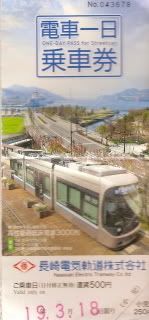
The tram lines are 1 (blue,) 3 (red,) 4 (yellow) and 5 (green.) There is no route #2. If anyone knows why not, they ain't talking.
Route 1 took us from our hotel in Shianbashi, all the way across town to Ohashi, near the A-Bomb epicentre. As we planned to go to the equivalent museum in Hiroshima, we skipped the Nagasaki Atomic Bomb Museum, choosing instead to go for a smaller, more personal experience: Nyokodo, the hut where Dr Nagai Takashi spent his last few years, and the small museum dedicated to him. Dr Nagai lost his wife to the A-Bomb, and spent the rest of his life researching the effects of radiation poisoning, even while he was dying of it himself. The first picture is Nyokodo, the one-room hut where he wrote 13 books while bedridden; the second is the ticket to the museum, with a reproduction of the Doctor's message "May peace..."
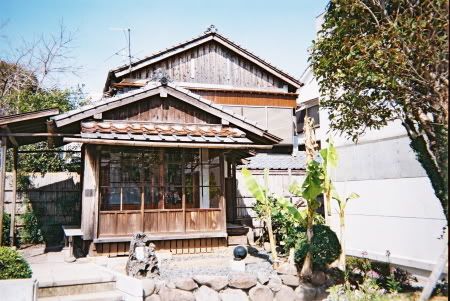

The museum is well worth going to and very moving - I wasn't even too distracted by the fact that the background music kept sounding as if it was going to turn into the theme from The Godfather. Penny in particular was very affected, and later that day we visited the nearby Christian Cemetery where Nagai is buried.
Our next stop was the rebuilt Nagasaki Cathedral, followed by the Peace Park, which used to be the location of the Urakami prison, which was vaporised by the bomb. In tribute to the people who were dying of thirst after the bomb fell, the entrance to the park is a water feature: A fountain in the shape of dove's wings.
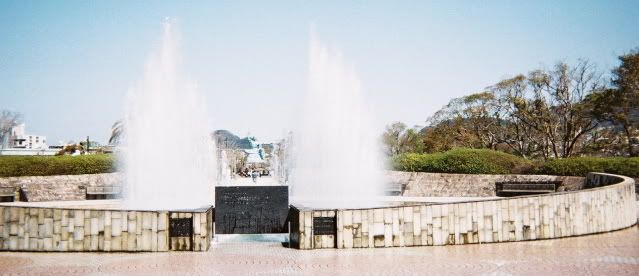
Through it you can see the main memorial, and unfortunately no, you're not wrong, it really is the ugliest statue on the planet. Reading the information, it becomes clear that the sculptor was attempting to do make it symbolise so many disparate things it's not really surprising that the end result was a bit of a mess.
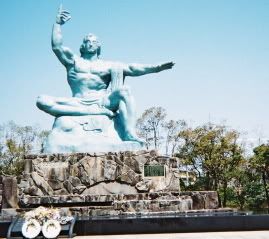
Scattered around the rest of the park are peace memorials donated by other countries. This one's representative of a lot of them - after looking at a few I imagined the Nagasaki park planners opening the box and saying with a fixed smile "Oh, another mother and child - just what I always wanted!"
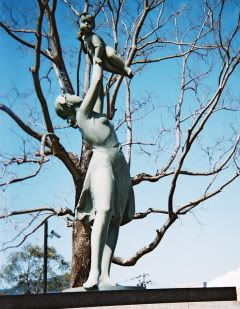
But this, very original and clever sculpture was by far my favourite:
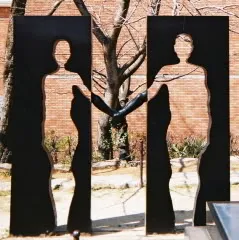
Our next stop was Hypocentre Park - this black monolith marks the exact point above which the centre of the explosion was (A-Bombs actually explode before reaching the ground) surrounded by concentric circles to represent fallout. Part of the original cathedral can be seen at the right.

The next place we visited was the one which had prompted me to suggest Nagasaki in the first place. The Sanno Shinto Shrine's Torii Arch is one-legged - the other leg having been destroyed by the bomb, this one was left standing, and has been preserved as a monument.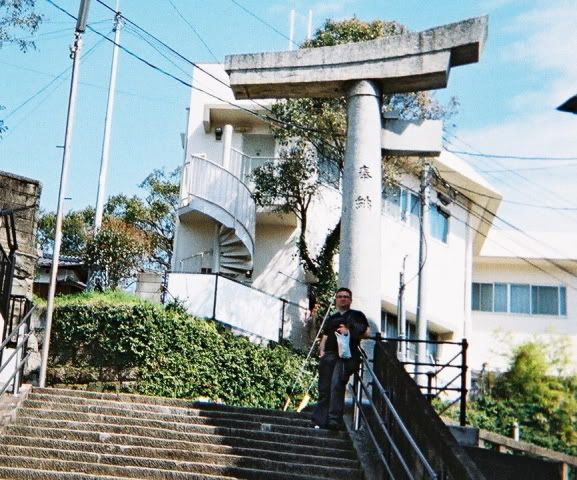
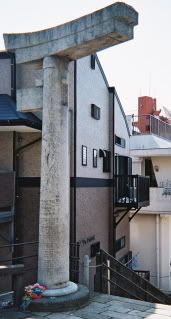
What remains of the other leg is in pieces alongside it.

As I've mentioned before, the one-legged arch is one of the Nagasaki locations featured in Crossing Midnight.
This all probably gives the impression that Nagasaki is a pretty bleak place, filled with ghosts. In fact, although many of the memorials are moving, there is a genuine and heartfelt optimism about the place, which in my opinion differentiates it from Hiroshima. I said before that Nagasaki was my favourite part of Japan by a long shot, and it's got a welcoming feel to it that's very aware of the massive tragedy that happened there, but almost aggressively seeks to find the good in people to counteract the evil.
The previous day we'd been at Oura Church, dedicated to the 26 Martyrs; on the 18th we visited the site of their crucifiction, which is not far from Nagasaki-Eki-Mae (the main rail station.)
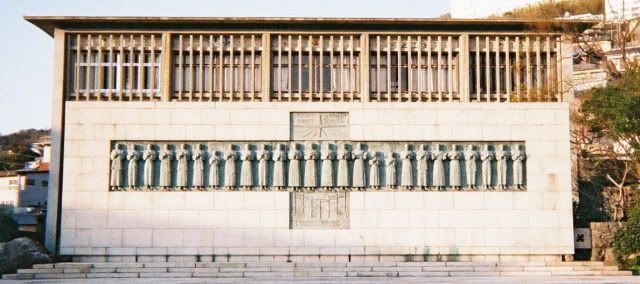
Next we visited something Penny was particularly keen to see, but which we found almost by accident, as it's hard to reach and bizarrely left off many of the tourist maps. Bizarrely considering how spectacular it is. Like something out of Terry Pratchett, the temple of Fukasuri-Ji is shaped like a turtle, with a giant statue of the goddess Kanon on its back. So big is it that I couldn't fit it into a single photo.
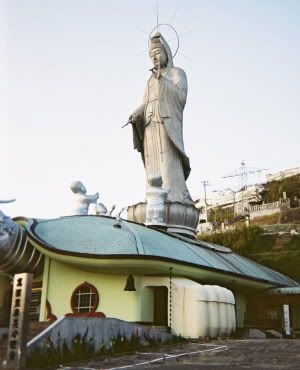
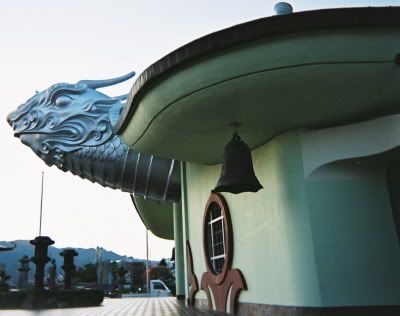
All this had barely taken us past lunchtime - we'd definitely had a busy day, and we had great weather for it - I got a tan. We had time to take the cable car, or ropeway, up Mount Inasa. There was a great panoramic view of the city but sadly the sun was in the wrong place for me to get good pictures, so here's the ropeway ticket as well as me and Penny at the cafe on top of the mountain. We'd finally got round to trying one of Nagasaki's big specialties, Kasutera. This is a real symbol of the city's East-meets-West culture, a European-style honey sponge cake (the name is a Japanese way of saying "Castella cake") that's you usually get served in two slices: One plain, one flavoured with green tea (the latter is delicious.) When Japanese people go on holiday to Nagasaki, this is what they take home as a souvenir.
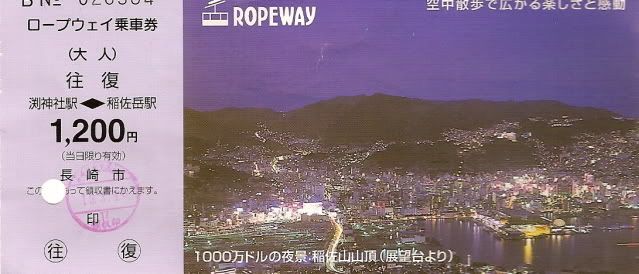

We still had some spare time and so we went to the Brick Hall to check our email - we had to sign up for membership first but hey, now I have a card that proves I can surf the internet in Nagasaki. Now those are memories money can't buy etc etc...
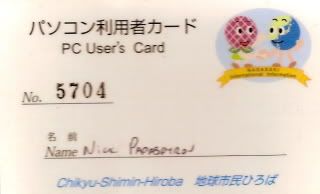
Finally it was time to go back to Shianbashi and get some dinner. Along the way, as a snack I tried the other Nagasaki specialsty (once again Penny had to abstain because it contains meat.) It's pork in a sort of bread roll, in a sauce that tastes not unlike gravy. Once again a real mix of East and West, I thought it was delicious. We had a lot of trouble finding out what the hell it was called, and it wasn't until the next morning at the station that we used the phrasebook on a woman giving out samples, who told us it was called "kakuni." I'm not convinced, it sounds like a rude word to me, but until I find out otherwise, kakuni it is.
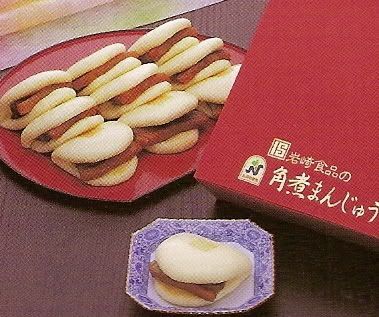
After dinner we went back to the Spectacle Bridge before finally going back to the hotel. As you can imagine I was in no hurry to leave Nagasaki but the whistle-stop tour of the Kyusu region ploughed on, and early on the 19th we set off for Aso, in the middle of a volcanic caldera.

The tram lines are 1 (blue,) 3 (red,) 4 (yellow) and 5 (green.) There is no route #2. If anyone knows why not, they ain't talking.
Route 1 took us from our hotel in Shianbashi, all the way across town to Ohashi, near the A-Bomb epicentre. As we planned to go to the equivalent museum in Hiroshima, we skipped the Nagasaki Atomic Bomb Museum, choosing instead to go for a smaller, more personal experience: Nyokodo, the hut where Dr Nagai Takashi spent his last few years, and the small museum dedicated to him. Dr Nagai lost his wife to the A-Bomb, and spent the rest of his life researching the effects of radiation poisoning, even while he was dying of it himself. The first picture is Nyokodo, the one-room hut where he wrote 13 books while bedridden; the second is the ticket to the museum, with a reproduction of the Doctor's message "May peace..."


The museum is well worth going to and very moving - I wasn't even too distracted by the fact that the background music kept sounding as if it was going to turn into the theme from The Godfather. Penny in particular was very affected, and later that day we visited the nearby Christian Cemetery where Nagai is buried.
Our next stop was the rebuilt Nagasaki Cathedral, followed by the Peace Park, which used to be the location of the Urakami prison, which was vaporised by the bomb. In tribute to the people who were dying of thirst after the bomb fell, the entrance to the park is a water feature: A fountain in the shape of dove's wings.

Through it you can see the main memorial, and unfortunately no, you're not wrong, it really is the ugliest statue on the planet. Reading the information, it becomes clear that the sculptor was attempting to do make it symbolise so many disparate things it's not really surprising that the end result was a bit of a mess.

Scattered around the rest of the park are peace memorials donated by other countries. This one's representative of a lot of them - after looking at a few I imagined the Nagasaki park planners opening the box and saying with a fixed smile "Oh, another mother and child - just what I always wanted!"

But this, very original and clever sculpture was by far my favourite:

Our next stop was Hypocentre Park - this black monolith marks the exact point above which the centre of the explosion was (A-Bombs actually explode before reaching the ground) surrounded by concentric circles to represent fallout. Part of the original cathedral can be seen at the right.

The next place we visited was the one which had prompted me to suggest Nagasaki in the first place. The Sanno Shinto Shrine's Torii Arch is one-legged - the other leg having been destroyed by the bomb, this one was left standing, and has been preserved as a monument.


What remains of the other leg is in pieces alongside it.

As I've mentioned before, the one-legged arch is one of the Nagasaki locations featured in Crossing Midnight.
This all probably gives the impression that Nagasaki is a pretty bleak place, filled with ghosts. In fact, although many of the memorials are moving, there is a genuine and heartfelt optimism about the place, which in my opinion differentiates it from Hiroshima. I said before that Nagasaki was my favourite part of Japan by a long shot, and it's got a welcoming feel to it that's very aware of the massive tragedy that happened there, but almost aggressively seeks to find the good in people to counteract the evil.
The previous day we'd been at Oura Church, dedicated to the 26 Martyrs; on the 18th we visited the site of their crucifiction, which is not far from Nagasaki-Eki-Mae (the main rail station.)

Next we visited something Penny was particularly keen to see, but which we found almost by accident, as it's hard to reach and bizarrely left off many of the tourist maps. Bizarrely considering how spectacular it is. Like something out of Terry Pratchett, the temple of Fukasuri-Ji is shaped like a turtle, with a giant statue of the goddess Kanon on its back. So big is it that I couldn't fit it into a single photo.


All this had barely taken us past lunchtime - we'd definitely had a busy day, and we had great weather for it - I got a tan. We had time to take the cable car, or ropeway, up Mount Inasa. There was a great panoramic view of the city but sadly the sun was in the wrong place for me to get good pictures, so here's the ropeway ticket as well as me and Penny at the cafe on top of the mountain. We'd finally got round to trying one of Nagasaki's big specialties, Kasutera. This is a real symbol of the city's East-meets-West culture, a European-style honey sponge cake (the name is a Japanese way of saying "Castella cake") that's you usually get served in two slices: One plain, one flavoured with green tea (the latter is delicious.) When Japanese people go on holiday to Nagasaki, this is what they take home as a souvenir.


We still had some spare time and so we went to the Brick Hall to check our email - we had to sign up for membership first but hey, now I have a card that proves I can surf the internet in Nagasaki. Now those are memories money can't buy etc etc...

Finally it was time to go back to Shianbashi and get some dinner. Along the way, as a snack I tried the other Nagasaki specialsty (once again Penny had to abstain because it contains meat.) It's pork in a sort of bread roll, in a sauce that tastes not unlike gravy. Once again a real mix of East and West, I thought it was delicious. We had a lot of trouble finding out what the hell it was called, and it wasn't until the next morning at the station that we used the phrasebook on a woman giving out samples, who told us it was called "kakuni." I'm not convinced, it sounds like a rude word to me, but until I find out otherwise, kakuni it is.

After dinner we went back to the Spectacle Bridge before finally going back to the hotel. As you can imagine I was in no hurry to leave Nagasaki but the whistle-stop tour of the Kyusu region ploughed on, and early on the 19th we set off for Aso, in the middle of a volcanic caldera.